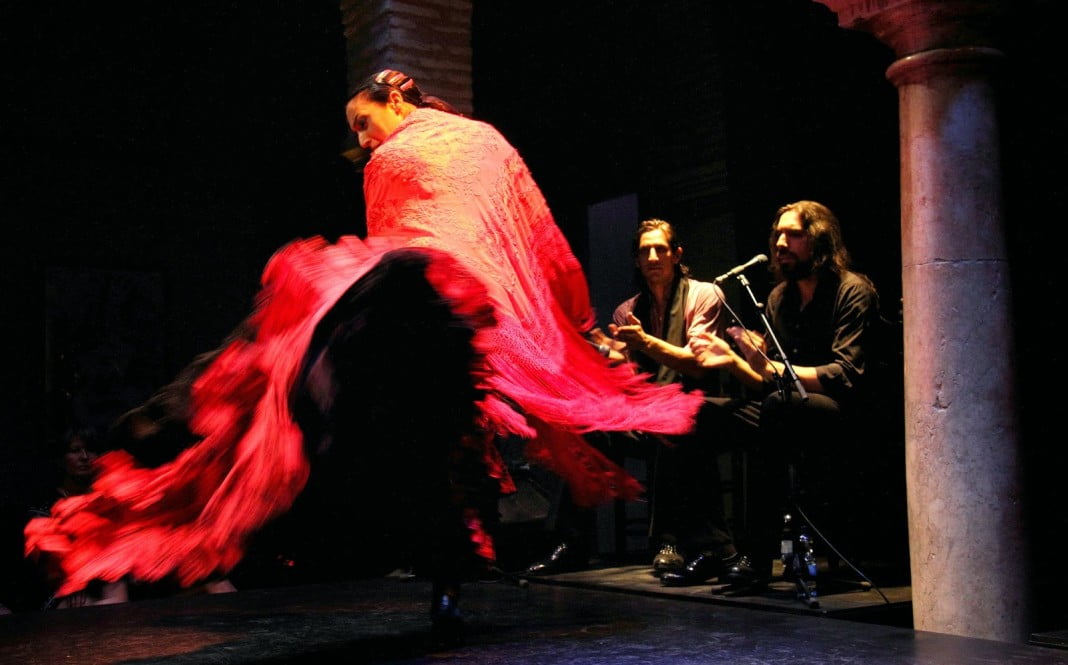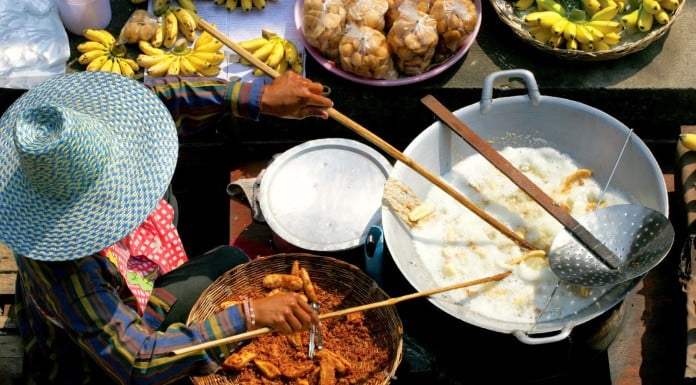Seville is a city of story and souls—from its flamencos, architecture, and multi-layered faiths. Dazzling and bewitching come night or day.
He could have been a converso. But he is definitely a gitano.
He has the song that echoes of his father’s. A primitive cry. A spiritual chant. Yet somewhere along the lead singer’s shattering jondo voice is a flowing expression of pride, anguish, and desire.
Like a call from the muezzin, the sound grows profound. The music intensifies. Between the rhythmic stamping of the dancer’s feet and the rattling of castanets, a hypnotized crowd tries to keep pace with the ecstatic strumming of Spanish guitars—all happening at once. The music reaches its climax and abruptly stops.
It’s eleven o’clock in Triana, a plebeian district in Seville. The air is thin and chilly. Gas lamps cast a soft glow onto the streets. Across the river from the barrio antiguo, I nurse a bottle of caña. The cheers, the claps, and the clanking of glasses inside the dusty tavern could signify only one thing: to the Sevillanos, the night had just begun.
It was only a week ago when my travel partner and I arrived on a cloudless November night in Seville. The dim airport managed to smile, flickering its neon lights from a distance in anticipation of our arrival. To see the letters of my last name all lit up at the top of the roof made me feel almost instantly familiar, as if I had been here before. Needless to say, it was my first time in the Andalusian capital.
That evening, we skipped the city and headed straight into the countryside. For two nights, we will be chasing the remaining elusive warm days of the Andalusian autumn while staying at an 18th-century hacienda—if we know where to find it. Its exact location is marked by a sign that says KM 594.
Without GPS and having to rely heavily on the tricky road signs, I began my litanies to La Macarena, the weeping Virgin patron of the Sevillanos, in hopes that the next turn would lead us to the Hacienda de San Rafael. Prayers were uttered. An hour passed, then came a revelation. With no particular reason, we veered the car to the right, off the asphalt, traversing the pebbled path passing a long stretch of olive groves. Against the stygian of the night and out of nowhere, a faint glimmer illuminated the unassuming guidepost of a metal cutout pointing to the entrance of the hacienda.


There is nothing as exhilarating as a road trip in the witching hour and the realization that you left the city far behind for another, entirely different world. At dawn, the Hacienda de San Rafael could not be in a more beautiful setting. We wake up to the sight of an almost endless stretch of earth, of oak trees and shrubbery from our windows. Had it been summer, the panorama would have been a golden field of sunflowers basking under the copious Spanish sun.
“The Hacienda used to be an olive farm. My parents started the restoration. Then my brother, Patrick, and I soon took over and began opening our doors to people looking for a hideaway transmitting rustic charm and sublimity,” tells Anthony Reid Mora-Figueroa, owner of Hacienda de San Rafael (The Reid brothers also run an intimate boutique hotel—Corral del Rey, nestled in the center of the old town of Seville). He leans over on the couch and gazes out the window as if surveying his modest kingdom while giving a pat to the hacienda’s pet dog, Bruno.
“From here, if you continue south, you will reach Jerez, and it’s easy to get lost in the town’s old sherry bodegas,” he added, and with a laugh, gave a word of caution, “Just don’t get drunk!” We hit the gas and accelerated our rented Fiat 500, passing several farm tractors and fincas. Amongst the rolling hills, we dashed through the chalky carreteras.
View this post on Instagram
We reached Jerez de la Frontera by midday. One can never resist partaking a sip of the pueblo’s oldest temptation—Sherry. The kind of drink to which the British have been addicted for centuries after Sir Francis Drake ravaged the port of Cadiz in 1587, taking with him 3,000 barrels of sherry. I had a sip of Amontillado and Oloroso and sampled Pedro Ximenez and Moscatel, which were too sweet for my liking. At the end, it was Manzanilla and Fino that won me over.


Returning to Seville, we wandered through the old quarters, gravitating to one of its many neighborhoods and attractions, like the 12th-century Catedral de Sevilla, built out from a mosque. The old minaret is now a bell tower dubbed as La Giralda. The Alcazar, also known as the Archive of the Indies, was the former residence of Abdul Al-Rahman III, the first caliph of Andalusia. Today, it is a UNESCO World Heritage Site and a must-see while visiting Seville.
At the nearby Barrio Sta. Cruz, gypsy street artists perform while children race under palms and heady orange trees. Andalusian cowboys in wide-brimmed hats swagger in 2000-year-old plazas once frequented by Jewish inhabitants.



When in Seville, do what the Sevillanos do. Eat late and eat where they dine. Indulge in some lazy afternoon siestas. Enjoy a sliver of jamon iberico, wallow on some bitter oranges and perhaps on occasion or during a fiesta, join the local crowd for the corrida as they cram inside the Plaza de Toros de la Real Maestranza.
View this post on Instagram
If there’s one thing about the Sevillanos that leaves a lasting impression, it’s their capriciousness. Take a trip in April, and witness the city’s remarkable transformation—from the solemn reverence of Holy Week processions to the vibrant revelry of the Feira de Abril (Spring Fair). Resistance is futile. Much like wandering through the labyrinthine passageways of Seville’s old town, only to stumble upon the delightful quirks that give the city its unique charm.
The night is young in Triana. Parties erupt spontaneously with Sherry and cañas (small draft beers) the preferred quaff. Once again, the gitano clacks his shoes against a backdrop of claps and olé’s. His hands lost in the strum. I gulped the last swig of my drink and succumbed to the crowd. I got up from my seat and flung my arms widely towards the empyrean. That instant, I realized that it will all be too early for the noise to dissipate into a soft hum.
BUTTER MY BAGUETTE
This website made of love strives to produce FREE CONTENT.
Help me tell more stories and keep this website free of any advertisement by supporting Flying Baguette in inspiring more people and connecting you with other cultures and communities around the globe. Donate a little or as much as you can afford to keep the magic of Flying Baguette going for years to come. Share your support through the icons below ⬇️

















I have been to Sevilla once, but traveling virtually with you this way has been great! I feel as if I need to go back and re-experience the city in a new light. I actually didn’t get a chance to take part in the nightlife when I went so hearing about it now, I’ll make sure to check it out when I go back!
-Flavia | Latina Traveler
The haciendo was a true gem, what a great find! May I ask how you found this unique accommodation? I enjoyed your post on Sevilla and it has given me a much more personal insight into its vibe than any other post I’ve read on it before. I understand it is a popular tourist destination, mostly for its architecture but again, I appreciate your unique spin and shared experience.
Carolin | Solo Travel Story
Wow, the way you have described the nightlife in Seville is quite amazing. That in itself is a big reason to visit this place. Must have been a wonderful experience during your stay there and to see the local way of life.
Seville seems absolutely magical. Your I look forward to visiting someday! Your hacienda in the olive groves sounds dreamy and a beautiful contrast to the lively city.
I enjoyed visiting Seville with you! I really enjoyed Triana when I visited and ate my weight in tasty tapas. The Alcazar is stunning. Totally agree about the sherry — I also decided Manzanilla was my favourite.